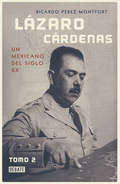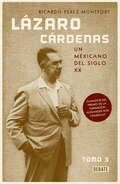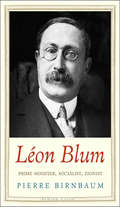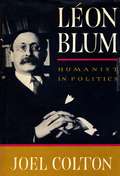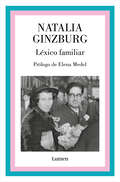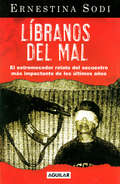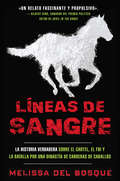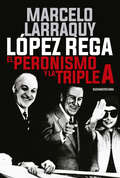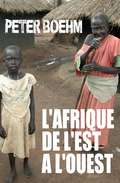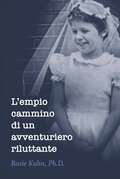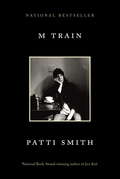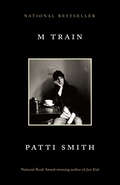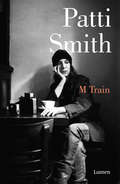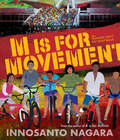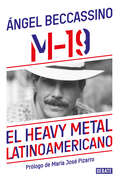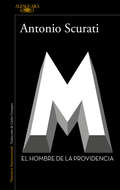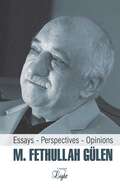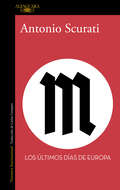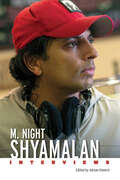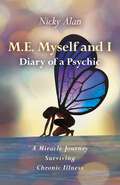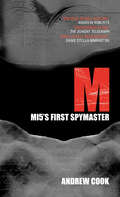- Table View
- List View
Lázaro Cárdenas. Un mexicano del siglo XX (El hombre que cambió al país #Volumen 2)
by Ricardo Pérez MontfortLa biografía definitiva sobre un hombre que transformó un país. El nombre Lázaro Cárdenas se convirtió en una alegoría. Es inevitable que al pronunciarlo se piense en la expropiación petrolera, la Revolución de 1910, la construcción del México moderno, la idea de soberanía y la noción misma de lo heroico. Pero esa metáfora encubre toda la complejidad de Lázaro Cárdenas del Río, un hombre de carne y hueso que tuvo una vida inaudita, trepidante y asombrosa, plena de sutilezas y claroscuros. En esta obra, Ricardo Pérez Montfort -uno de los mayores investigadores del expresidente- relata sin cortapisas la vida del michoacano, con brillante fluidez explica las motivaciones que lo guiaron y contextualiza las decisiones de quien tal vez sea uno de los políticos mexicanos más reconocidos pero más desconocidos, más alabados pero más envueltos en mitos. En este primer tomo de Lázaro Cárdenas. Un mexicano del siglo XX, se profundiza en los años de formación del general: su infancia y juventud, su participación en la Revolución mexicana, sus inicios en la política y su meteórico ascenso en los pasillos del poder: en resumen, los hechos que configuraron al hombre que cambiaría México.
Lázaro Cárdenas: Un mexicano del siglo XX
by Ricardo Pérez MontfortLos años que definieron una vida y una idea de patria. En este segundo tomo de Lázaro Cárdenas. Un mexicano del siglo XX, se relata el periodo central en la vida del General: aquél que transformó nuestro país y lo catapultó a la historia. Los años de su sexenio (1934-1940) y de su encargo como secretario de la Defensa Nacional -durante la Segunda Guerra Mundial, ni más ni menos- son analizados con una prosa rigurosa y ágil por Ricardo Pérez Montfort, quien desmonta mitos del michoacano, de la Expropiación Petrolera, de su visión de la política y de su existencia tras Los Pinos. Así, en este tomo II de la biografía más documentada de Cárdenas del Río se presentan las coordenadas imprescindibles para entender el México de hoy, sus luchas y contradicciones.
Léeme.txt
by Chelsea ManningLa extraordinaria autobiografía de una de las activistas y mujeres trans más relevantes de nuestro tiempo. Febrero de 2010. Chelsea Manning, una analista de inteligencia militar estadounidense destinada en Irak, revela 720.000 documentos militares clasificados a través de WikiLeaks. Su coraje se apodera del mundo entero al protagonizar la mayor filtración de la historia. Manning fue acusada de veintidós cargos y condenada a treinta y cinco años de prisión militar. Pero, al día siguiente de conocer su sentencia, declaró su identidad de género como mujer y empezó otra lucha: la del derecho a la transición en una prisión de hombres. En 2017, después de un largo desafío legal y un gran apoyo civil, el presidente Obama conmutó su pena y la dejó en libertad. Hoy Chelsea Manning es una de las mayores activistas globales por la transparencia de la información y por los derechos de las mujeres trans. Léeme.txt estádestinado a convertirse en uno de los testimonios definitivos de nuestra era digital. Es una historia impresionante de rebelión personal, resiliencia y supervivencia: desde la adolescencia atormentada de Manning y los motivos que la llevaron a alistarse en el ejército hasta el juicio kafkiano al que fue sometida y su heroica lucha por la libertad. «Chelsea Manning es la mayor heroína que jamás ha existido».Vivienne Westwood Reseñas:«Una de las personas vivas más valientes del mundo».Yanis Varoufakis «Una lectura fascinante, llena de detalles y giros inesperados que contrarrestan muchas de las suposiciones hechas sobre Chelsea Manning... Empieza como una novela de Jason Bourne».The Guardian «Una heroína para millones de personas».Alan Moore «Apasionante... Se necesitan cualidades extraordinarias para hacer algunas de las cosas narradas en este libro».The Observer
Léon Blum
by Pierre BirnbaumLéon Blum (1872–1950) was many things: a socialist and political activist, leader of the Popular Front; a dedicated statesman who served as France's prime minister three times; a hero who courageously opposed anti-Semitism, Nazi aggression, and the pro-German Vichy government; a passionate lover of women, art, and life. A tireless champion for workers’ rights, Blum dramatically changed French society by establishing the forty-hour work week, paid holidays, and collective bargaining on wage claims. He was also a proud Jew and Zionist, and a survivor who endured the horrors of Buchenwald and Dachau. Unlike previous biographies that downplay the significance of Blum’s Jewish heritage on his progressive politics, Pierre Birnbaum’s portrait depicts an extraordinary man whose political convictions were shaped and driven by his religious and cultural background. The author powerfully demonstrates how Blum’s Jewishness was central to his milieu and mission from his earliest entry into the political arena in reaction to the Dreyfus Affair, and how it sustained and motivated him throughout the remainder of his life. Birnbaum’s Léon Blum is a critical chapter in the larger history of Jews in France.
Léon Blum: Humanist in Politics
by Joel ColtonJohn Colton is a meticulous researcher and a fine craftsman. In his political biography of Leon Blum, these two qualities are beautiully blended; none of the available evidence appears to have been over looked, and the enormous mass of variegated material has been transmuted in a polished, richly tapestried, and absorbing narrative.
Léxico familiar
by Natalia GinzburgEl libro más fascinante de Natalia Ginzburg, por cuyas páginas autobiográficas se pasea en bata la historia de la Italia antifascista y donde brilla todo el talento de la autora. «Aunque esté basado en hechos reales, me gusta pensar que Léxico familiar va a leerse como una novela, pidiéndole a este libro todo lo que solemos pedir a la ficción.» Así se expresaba Natalia Ginzburg hablando de este magnífico texto que cuenta su infancia y su juventud, y donde aparecen los nombres reales de parientes y amigos, entre ellos Cesare Pavese y Elio Vittorini. Léxico familiar habla de los Levi, una familia judía y antifascista que vivió en Turín, en el norte de Italia, desde 1930 hasta 1950. Natalia era una de las hijas del profesor Levi y fue testigo privilegiado de los momentos íntimos de la familia, de ese parloteo entre padres y hermanos que se convierte en un idioma secreto. A través de este léxico tan peculiar vamos conociendo al padre y a la madre de Natalia, unas personas que inundan de vitalidad el libro; veremos también a los hermanos de la autora, a su primer esposo, a políticos de gran valía y a muchos de los intelectuales que animaban las tertulias en estas décadas tan importantes del siglo XX. La crítica ha dicho...«Ginzburg recrea los sentimientos y las relaciones, las simpatías y antipatías, los amores y odios de todas las familias, tan predecibles y caprichosos, pero también, una generación tras otra, la singularidad de los hijos.»Italo Calvino «Llegué a Natalia Ginzburg vestida con los trapos sucios del desarraigo. Ella se reveló ante mí como una mujer que vivía en mi cabeza sin saberlo. Ella me enseñó a lavar mi propia ropa, llorando.»Karina Sainz Borgo «Distante, divertida y melancólica. ¿De dónde viene su estilo? ¿Está conscientemente construido o inconscientemente ocultado? ¿Inventado o heredado?El sello de Ginzburg es inconfundible. [...] Ella nos dio un nuevo modelo para la voz femenina.»Rachel Cusk «Su obra cumbre. Autobiografía de infancia y juventud, se lee como novela. Por sus páginas pasea en bata la historia de la Italia antifascista de la mano de los Levy, su propia familia. Anécdotas cotidianas se mezclan con precisas y profundas reflexiones, rescatando los secretos y sucesos que se esconden en la intimidad de los que la rodean.»Miguel Polo, Gentleman «Léxico familiar son todas esas expresiones únicas que funcionan tanto como chistes privados como elementos de enorme capaz evocadora, capaces de volvernos niños en un momento sentados otra vez en el comedor familiar. Son las pequeñas historias que transcurren en la intimidad de la familia y que tanto significan para nosotros aunque las creamos olvidadas.»Cuchitril Literario «Una de las escritoras más influyentes del siglo XX. La sencillez de su estilo y la claridad de su prosa siguen seduciendo.»Aloma Rodríguez, Ahora «Natalia Ginzburg es una autora que hay que leer.»Luis Soravilla «Un libro fascinante y autobiográfico, por las páginas del cual se pasea en bata la historia de la Italia antifascista. Con su discreción y su sutileza habituales, Ginzburg siempre consigue hablar de nosotros cuando parece que en realidad habla solo de sí misma. Una escritora imprescindible en nuestra era.»Gentleman «No soy ella, pero aquí -en esta lectura, ante este libro-, por arte de literatura, me siento Natalia Ginzburg, quizá porque haya dicho algo de mí que yo no sospechaba, y espero que, al cerrar la última página de Léxico familiar, todos sus lectores nos reconozcamos en ella.»Elena Medel «Hay algo de Beckett en la prosa de Ginzburg; de Chéjov, que ella admiraba profundamente; y de las últimas obras de Shakespeare, donde la tragedia suele ocurrir entre bambalinas. Una de las ironías de la
Líbranos del mal
by Ernestina SodiUno de los secuestros que mayor consternación ha causado en la opinión pública mexicana fue el de la escritora Ernestina Sodi y su hermana, la actriz Laura Zapata, perpetrado por la banda de secuestradores "Los Tiras", quienes se encuentran tras las rejas a raíz de la denuncia que ambas presentaron después de su liberación. Las hermanas fueron privadas de su libertad la noche del 22 de septiembre del 2002 a la salida de un teatro, después de asistir a un ensayo de la actriz; golpeadas y amedrentadas, fueron trasladadas a una casa que los secuestradores adaptaron para retener a sus víctimas y donde permanecieron encerradas, con los ojos vendados, mientras los secuestradores iniciaban las negociaciones para pedir su rescate. Después de transcurridos 18 días, y al no obtener respuesta de los familiares de sus víctimas, los secuestradores liberaron a Laura Zapata. Sin embargo, Ernestina Sodi permaneció cautiva durante tres meses, hasta que su hermana menor, la cantante y actriz Thalía, completó la suma exigida.
Líneas de sangre: La historia verdadera sobre el cartel, el FBI y la batalla por una dinastía de carreras de caballos
by Melissa del BosqueDinero, drogas y cárteles: eso es lo que el novato agente del FBI esperaba tener cuando lo enviaron al pueblo fronterizo de Laredo; pero en cambio, se encontró con una tarea sedentaria, redactando reportes de inteligencia acerca de la guerra contra el narcotráfico. Hasta que, un día, le piden a Lawson que chequee una pista anónima: un caballo que se vendió en una subasta en Oklahoma por un precio mucho más elevado de lo usual, y el comprador fue Miguel Treviño, uno de los líderes de los Zetas, el cártel más brutal de México. La fuente sugirió que Treviño estaba lavando dinero mediante las carreras de caballos Cuarto de Milla. De ser cierto, eso le brindaría a un novato como Lawson la oportunidad perfecta para infiltrar el cártel. Lawson se une en equipo con la agente más experimentada, Alma Pérez, y, enfrentándose a una misión imposible, van en busca del caballero más aterrador del mundo de la droga. En Bloodlines, la periodista ganadora del Premio Emmy y del National Magazine Award [Premio Nacional de Revistas], Melissa del Bosque, traza el peligroso intento de Lawson y Pérez por desmantelar la dinastía en carreras de caballos del líder del cártel, construida sobre extorsión y dinero sangriento. Habiendo tenido acceso a evidencias de investigación y entrevistado en profundidad a los protagonistas de la historia, del Bosque capitaliza más de tres años de exploración y décadas como reportera en México y en la frontera, y lo convierte en una narrativa cautivante sobre la codicia y la corrupción. Bloodlines ofrece una mirada sin precedentes al trabajo interno de los Zetas y de las agencias federales de los EE. UU., y abre una nueva perspectiva sobre la naturaleza dinámica de la guerra del narcotráfico y su expansión mundial.
López Rega: El peronismo y la Triple A
by Marcelo LarraquyVida de José López Rega, un anónimo policía retirado al servicio del matrimonio de Juan Domingo Perón e Isabel Martínez, que terminó influyendo en el destino de la Argentina en los años setenta, con la gestación de la organización paraestatal Triple A durante el tercer gobierno peronista. Más de dos mil muertos, en crímenes todavía impunes, fueron el antecedente del terrorismo de Estado de la dictadura militar que usurpó el poder en 1976. Este libro puede leerse como la clásica biografía de un personaje oscuro, menor, al que los acontecimientos históricos le dieron dimensión política. José López Rega empieza a gravitar en la vida de los argentinos en 1966, cuando ingresa al servicio doméstico del matrimonio de Juan Perón e Isabel Martínez; por eso, a la vez, es una historia íntima de Perón. En esta notable investigación, Marcelo Larraquy profundiza además en las circunstancias que originaron la violencia durante el tercer gobierno peronista (1973-1976), de la cual la Triple A comandada por "el Brujo" fue brazo ejecutor, y que fue el preludio de la feroz represión desplegada por la dictadura. Este intenso trabajo de reelaboración actualiza una obra necesaria para comprender no sólo qué se discute hoy sobre los años setenta, sino también la naturaleza de las disputas en el interior del aparato justicialista.
L’Afrique de l’Est à l’Ouest
by Peter BoehmL’AFRIQUE DE L’EST À L’OUEST, récit de voyage Peter Boehm traverse l’Afrique dans des quatre-quatre roulant à toute vitesse, des cars bringuebalants et des trains fichus. En presque six mois, il traverse neuf pays en parcourant plus de dix mille kilomètres : Somalie, Djibouti, Éthiopie, Soudan, Tchad, Nigeria, Niger, Mali et Sénégal. Ce voyage était long à couper le souffle, énervant mais pas ennuyeux. Les personnes qu’il a rencontrées étaient intéressantes, bizarres et émouvantes, mais elles ne font ni froid ni chaud à personne. Peter Boehm fait le portrait des psychiatres de Somalie qui considèrent toute la population nationale comme des fous - ainsi que les Somaliens eux-mêmes et même l’auteur à la fin ! Au Soudan, il rencontre des médecins qui « referment » les femmes ; au Tchad, des enfants de la rue qui sont fin prêts pour l’Allemagne ; au Mali, des guérisseurs traditionnels qui sont également médecins de famille, Dr Sommer et Kummertante ; au Nigeria, des chefs traditionnels devant qui les sujets s’agenouillent et des juges islamiques qui goûtent, comme du vin gouleyant, aux coups de fouets ordonnés par eux. En supplément, Peter Boehm a exactement suivi le protocole de l’Européen que l’Afrique embrouille et transforme. Peter Boehm emploie un ton laconique et sobre de toute fausse sensiblerie. Comme vous n’en avez jamais lu sur l’Afrique.
L’empio cammino di un avventuriero riluttante
by Dr Rosie KuhnNeanche in un milione di anni avrei sognato una vita simile per me. Da bambina immaginavo solo di sposarmi il prima possibile, avere dei figli e vivere per sempre felice e contenta. Fine della storia. Qualcuno, non so chi, deve avermi lanciato una maledizione, quella che dice: "Che tu possa avere una vita interessante". Per quale altro motivo una brava ragazza cattolica dovrebbe finire per avere una vita come questa? Cosa avrebbe spinto la figlia di un medico del Midwest a fare il tipo di scelte che ho fatto io? Scegliere una vita come madre non affidataria di bambini, attraversare l'Oceano Atlantico su una goletta di ventotto metri, acquisire tre lauree magistrali e un dottorato e scrivere un libro sull'autoimprenditorialità... Cosa è successo al mio sogno di essere una mamma felice che gioca con i suoi figli? Sono abbastanza sicura che sia stata una maledizione. Raramente siamo in grado di comprendere lo svolgersi della nostra storia finché non cogliamo l'opportunità di guardarci indietro e di esserne testimoni.
L’eterno istante in cui mi sono sentita felice
by Hitomi IidaUna lettera d'amore per la mia anima gemella capace di guardare con occhi nostalgici oltre il tempo e lo spazio.
M Train
by Patti SmithFrom the National Book Award-winning author of Just Kids: an unforgettable odyssey into the mind of this legendary artist, told through the prism of cafés and haunts she has visited and worked in around the world. M Train is a journey through seventeen "stations." It begins in the tiny Greenwich Village café where Smith goes every morning for black coffee, ruminates on the world as it is and the world as it was, and writes in her notebook. We then travel, through prose that shifts fluidly between dreams and reality, past and present, across a landscape of creative aspirations and inspirations: from Frida Kahlo's Casa Azul in Mexico, to a meeting of an Arctic explorer's society in Berlin; from the ramshackle seaside bungalow in New York's Far Rockaway that Smith buys just before Hurricane Sandy hits, to the graves of Genet, Plath, Rimbaud and Mishima. Woven throughout are reflections on the writer's craft and on artistic creation, alongside signature memories, including of her life in Michigan with her husband, guitarist Fred Sonic Smith, whose untimely death was an irremediable loss. For it is loss, as well as the consolation we might salvage from it, that lies at the heart of this exquisitely told memoir, one augmented by stunning black-and-white Polaroids taken by Smith herself. M Train is a meditation on endings and on beginnings: a poetic tour de force by one of the most brilliant, multi-platform artists at work today.
M Train
by Patti SmithFrom the National Book Award-winning author of Just Kids: an unforgettable odyssey of a legendary artist, told through the prism of the cafés and haunts she has worked in around the world. It is a book Patti Smith has described as "a roadmap to my life." M Train begins in the tiny Greenwich Village café where Smith goes every morning for black coffee, ruminates on the world as it is and the world as it was, and writes in her notebook. Through prose that shifts fluidly between dreams and reality, past and present, and across a landscape of creative aspirations and inspirations, we travel to Frida Kahlo's Casa Azul in Mexico; to a meeting of an Arctic explorer's society in Berlin; to a ramshackle seaside bungalow in New York's Far Rockaway that Smith acquires just before Hurricane Sandy hits; and to the graves of Genet, Plath, Rimbaud, and Mishima. Woven throughout are reflections on the writer's craft and on artistic creation. Here, too, are singular memories of Smith's life in Michigan and the irremediable loss of her husband, Fred Sonic Smith. Braiding despair with hope and consolation, illustrated with her signature Polaroids, M Train is a meditation on travel, detective shows, literature, and coffee. It is a powerful, deeply moving book by one of the most remarkable multiplatform artists at work today.From the Hardcover edition.
M Train
by Patti SmithNational Best Seller From the National Book Award-winning author of Just Kids: an unforgettable odyssey of a legendary artist, told through the prism of the cafés and haunts she has worked in around the world. It is a book Patti Smith has described as "a roadmap to my life." M Train begins in the tiny Greenwich Village café where Smith goes every morning for black coffee, ruminates on the world as it is and the world as it was, and writes in her notebook. Through prose that shifts fluidly between dreams and reality, past and present, and across a landscape of creative aspirations and inspirations, we travel to Frida Kahlo's Casa Azul in Mexico; to a meeting of an Arctic explorer's society in Berlin; to a ramshackle seaside bungalow in New York's Far Rockaway that Smith acquires just before Hurricane Sandy hits; and to the graves of Genet, Plath, Rimbaud, and Mishima. Woven throughout are reflections on the writer's craft and on artistic creation. Here, too, are singular memories of Smith's life in Michigan and the irremediable loss of her husband, Fred Sonic Smith. Braiding despair with hope and consolation, illustrated with her signature Polaroids, M Train is a meditation on travel, detective shows, literature, and coffee. It is a powerful, deeply moving book by one of the most remarkable multiplatform artists at work today.From the Hardcover edition.
M Train
by Patti SmithTras ser galardonada con el National Book Award por Éramos unos niños, Patti Smith crea M Train, un singular y bellísimo libro de memorias de un icono y de una época. En él, la gran artista muestra la parte más poética de su vida cotidiana como si lo hiciera a través de un caleidoscopio. Patti Smith revisita las cafeterías que más ha frecuentado a lo largo de los años y que convertía en lugares de creación, empezando por el Café 'Ino de Greenwich Village de Nueva York. Su vida de poeta, dramaturga, cantante, artista y peregrina se revela aquí como si se tratara de un mapa de carreteras. Gracias a una prosa que fluye sin contrastes de los sueños a la realidad, del pasado al presente, acompañamos a la autora en sus viajes, entramos en la Casa Azul de Frida Kahlo en México, visitamos las tumbas de Genet, Plath, Rimbaud o Mishima, somos testigos de su relación con Robert Mappelthorpe, y recordamos su matrimonio con el guitarrista Fred Sonic, la retirada de los escenarios para dedicarse a su familia y su vuelta triunfal al mundo de la música. Si alguien alguna vez soñó con acompañar a Patti Smith en sus viajes, ha llegado la hora de subirse a M Train: la experiencia merece la pena. «Patti Smith nos ha honrado con una poética obra maestra, una espléndida invitación a abrir un cofre de los tesoros que nunca antes se había abierto.»Johnny Depp
M is for Movement
by Innosanto NagaraHere is the story of a child born at the dawn of a social movement.At first the protests were in small villages and at universities. But then they spread. People drew sustenance from other social movements in other countries. And then the unthinkable happened.The protagonist in this fictionalized children's memoir is a witness and a participant, fearful sometimes, brave sometimes too, and when things change, this child who is now an adult is as surprised as anyone.
M-19 El heavy metal latinoamericano
by Ángel Beccassino"Volver a publicar estos diálogos es una contribución a esta nueva oportunidad que en estos últimos años se ha abierto en Colombia para dejar las armas atrás. Y es un aporte a la reflexión de quienes sienten que desde entonces muy poco ha cambiado en el país, salvo cuantitativamente, ya que mucho de lo que veíamos en aquellos días hoy se ha agravado". Ángel Beccasino A finales de 1988, el periodista y fotógrafo Ángel Beccassino se internó con varios integrantes del M-19 y de las FARC en un lugar controlado por este grupo guerrillero. Durante un mes, Carlos Pizarro Leongómez, entonces comandante del M-19, intentó convencer al secretariado de las FARC de sumarse a un proceso de paz. El autor convivió allí con sus entrevistados y pudo obtener largas horas de conversaciones con Pizarro, Manuel Marulanda, Jacobo Arenas y Afranio Parra, entre otros. Más adelante continuó las entrevistas con el líder del M-19 y con otros miembros de este grupo como Antonio Navarro Wolff, Vera Grabe y Otty Patiño, en medio de los diálogos para desmovilizarse desde el campamento del movimiento guerrillero en Santodomingo, Cauca. Ahora, más de tres décadas después del magnicidio de Pizarro y de la primera edición de este libro, y ante el triunfo de Gustavo Petro en las pasadas elecciones a la presidencia de Colombia, cobran relevancia estas entrevistas, en especial las concedidas por el famoso comandante del M-19, pues recogen su visión de país y las ideas que inspiraron al movimiento, tanto en su creación, como en su proceso de desmovilización.
M. El hombre de la providencia
by Antonio ScuratiTras M. El hijo del siglo (Premio Strega 2019, uno de los libros del año para Babelia y elogiado por Roberto Saviano como «una obra maestra»), llega la segunda entrega del gran proyecto literario de nuestro tiempo «La mejor vacuna narrativa de la que disponemos contra el populismo.»Sette – Corriere della Sera En 1925, una figura de camisa negra y gesto arrogante comienza a ocupar todos los intersticios de la vida pública italiana. Benito Mussolini, una vez que se ha convertido en el presidente del Consejo más joven de la historia de Italia, se prepara para el siguiente paso del proyecto fascista: fundir su nombre con el de su propio país. Pero la senda del autoritarismo no es sencilla: luchas internas en el partido, durísimas batallas parlamentarias, la amenaza revolucionaria, la necesidad de expandirse territorialmente, una turbulenta vida personal y palaciega, intentos de asesinato y la nueva relación con un joven Herr Hitler, cada vez más popular. Todo para que Mussolini, fascismo e Italia sean uno. Este proceso irá tomando cuerpo hasta que, en 1932, se cumpla una década de la marcha sobre Roma. Pero no hay tiempo para mirar atrás, el futuro parece encerrar una promesa brillante para el fascismo. La crítica ha dicho...«Un viaje literario que nos afecta y concierne a todos.»Corriere della Sera «Una travesía literaria inconmensurable y sin precedentes.»La Stampa «Este fresco de Scurati presenta a los protagonistas de la historia en su dimensión privada, revelando sus vicios y debilidades es un escrutinio sin escrúpulos.»Il Fatto Quotidiano Sobre M. El hijo del siglo:«Se esperaba desde hace décadas. Una obra maestra.»Roberto Saviano «Una de las novelas del año.»Ignacio Martínez de Pisón «Si este año solo vas a leer un libro, que sea este.»Matías Vallés, Diario de Mallorca - La Almudaina «Una novela [de] incontestables conquistas literarias [...]. Scurati revisa la historia. Como Yourcenar, Gore Vidal, Sebald, Echenoz o Cercas. [...] Al partisano y narrador Italo Calvino le hubiese encantado.»El País «Un perfecto equilibrio entre investigación histórica e introspección psicológica. [...] Aconsejo leer M como una distopía. Lo que nos narra pertenece al ayer, pero podría escribir el mañana.»Rafael Narbona, El Cultural de El Mundo «Este libro hay que escalarlo. Tiene esa mezcla de literatura e historia que tanto nos gusta: la elegancia de Éric Vuillard y la extensión y el arrojo de Galdós.»Sergio del Molino «Aquí queda revelado el ADN del fascismo.»La Repubblica «Una lección de historia antifascista en forma de novela.»The New York Time
M. Fethullah Gulen: Essays – Perspectives – Opinions
by Tughra BooksAn intellectual with a distinctive spiritual charisma, a prolific writer and poet, M. Fethullah Gülen has been an extremely effective and popular scholar of Islam for the last 3 decades. This work presents Gülen through a short biography, a selection of various articles, his views on modern education and its importance, and how he has been presented in the media. It is by no means a comprehensive presentation of his life and influence upon millions of people; rather, it is meant to serve as an introduction to those who desire a better understanding of Gülen&’s message and what it has accomplished over the years.
M. Los últimos días de Europa
by Antonio ScuratiLOS ÚLTIMOS DÍAS DE EUROPA EL PRINCIPIO DEL FIN: HITLER, LAS LEYES RACIALES, LA GUERRA.LA GRAN NOVELA DE NUESTRO TIEMPO LLEGA A SUS AÑOS CRUCIALES Más de medio millón de ejemplares vendidos de los dos primeros volúmenes, publicados en 40 países «Scurati revisa la historia. Como Yourcenar, Gore Vidal, Sebald, Echenoz o Cercas».Javier Aparicio Maydeu, El País Con febril precisión, Antonio Scurati continúa su «novela total» reconstruyendo el delirio de un Mussolini ilusionado con poder influir en las decisiones del Führer, más solo que nunca y por fin consciente de la debilidad italiana cuando declara que ha llegado «la hora de las decisiones irrevocables». Acabada la guerra civil española, el continente se hunde en un nuevo conflicto internacional apenas veinte años después del fin del anterior. Estos son los últimos días de Europa: la culminación del autoengaño de una Italia fascista doblegada ante la infamia de las leyes raciales y el pacto con la Alemania nazi. La crítica ha dicho:«Lo que nos narra pertenece al ayer, pero podría escribir el mañana».Rafael Narbona, El Cultural «Formidable e impresionante. [...] Un ejemplo brillante del poder de la literatura y de la capacidad para articular el tiempo histórico y el tiempo humano».Le Monde«En la gigantesca reconstrucción que Antonio Scurati está haciendo de Mussolini y de su régimen, este volumen me ha parecido el más apasionante. [...] Su doble registro [...] le da a la lectura una intensidad inaudita».Corrado Augias, Il Venerdì di Repubblica «Me han gustado muchísimo las novelas de Antonio Scurati sobre Mussolini».Pierre Lemaitre «Una lección histórica de antifascismo disfrazada de novela».The New York Times«M inventa un género literario nuevo capaz de hacer que la historia sea tan palpitante como la intriga de una novela. [...] Una de las empresas literarias más fascinantes y ambiciosas de las últimas décadas».Enzo Traverso, La Lettura «Una narración capaz de comunicar algo de la experiencia caótica que es la historia».Orlando Figes, autor de Los europeos «Aquí queda revelado el ADN del fascismo».La Repubblica «Scurati está escribiendo una novela de miedo».Domingo Ródenas de Moya, El Periódico «Tras narrar el ascenso de Mussolini con M1 y los años del régimen con M2, Scurati aborda ahora el corazón de las tinieblas de la Italia fascista».Luca Mastrantonio, Corriere della Sera
M. Night Shyamalan: Interviews (Conversations with Filmmakers Series)
by Adrian GmelchAs a visionary and distinctive filmmaker, M. Night Shyamalan (b. 1970) has consistently garnered mixed reception of his work by critics and audiences alike. After the release of The Sixth Sense, one of the most successful films from the turn of the millennium, Shyamalan promptly received two Academy Award nominations for Best Director and Best Original Screenplay. Since then, lauded films such as Unbreakable (2000), Signs (2002), and Split (2016) have alternated with less successful and highly criticized works, such as Lady in the Water (2006), The Last Airbender (2010), and After Earth (2013). Yet despite his polarizing aesthetics and uneven career, for two decades Shyamalan has upheld his cinematic style and remained an influential force in international film. With interviews spanning from 1993 through 2022, M. Night Shyamalan: Interviews is the first survey of conversations with the filmmaker to cover the broad spectrum of his life and career. This collection includes interviews with renowned American film journalists such as Jeff Giles, Carrie Rickey, and Stephen Pizzello, and reflects the intense international interest in Shyamalan’s work by including newly translated conversations from French and German sources. Through its thorough and careful curation, this volume is bound to shake up readers’ perceptions of M. Night Shyamalan.
M.E. Myself and I - Diary of a Psychic: A Miracle Journey Surviving Chronic Illness
by Nicky Alan Nicky Alan'This book is a refreshing and real story. Horrific, but real. Her sufferings have made her the strong, compassionate woman she now is, a shining light, a beacon of hope to the world. This is her unique contribution to humanity, timeless in its strong message of hope to us all. You will not be able to put this book down, guaranteed!' Eileen McCourt, 'Living the Magic - Connecting the physical and Spiritual Worlds'M.E. Myself and I follows the story of a woman struck down with M.E and Fibromyalgia in the prime of her life as a successful TV psychic medium. Left with nothing but two dustbin bags, demons from the past and her two dogs, she embarks on an incredible journey. Grieving her old life and begrudgingly accepting guidance from angels and spirit guides after losing her faith, she finds a reason to live from the brink of suicide by experiencing celestial miracles and a passion to write.This inspirational self-help spiritual memoir highlights a chronic illness pandemic sweeping through the world that society has shamefully neglected. Her esoteric voice representing the &‘millions missing' brings hope, faith and a definitive strength of the human spirit during the injustice of one life altering episode after another.
M: MI5's First Spymaster
by Andrew CookThis is the amazing true story of the real 'M', William Melville, MI5's founding father and the inspiration for Ian Flemings's character in "James Bond". Melville was one of the most influential counter-espionage figures of the twentieth century. From a tiny outfit based in Victoria Street, London, the counter-intelligence organisation that Melville lobbied the Government to create is today a household name and one of the world's leading intelligence agencies. He was perfect for the job, a velvet-gloved hardman who had run Scotland Yard's Special Branch and whose career had already taken in some of London's great crime dramas including the Jack the Ripper Investigation, countering Irish Republican terrorism, assassination attempts on Queen Victoria and anarchist bomb plots. Now, with the help of recently declassified records, family material and documents that have still not officially seen the light of day, the story of his Secret Service career - including the breaking of German spy rings prior to the outbreak of World War I - can finally be told.
